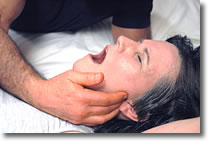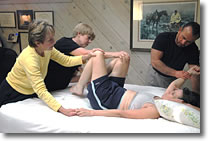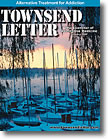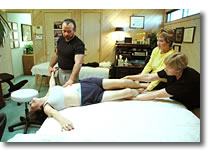Online publication
only
Page 1, 2 
 Reichian-myofascial
release therapy is a new and unique treatment – the combination
of two of the most successful body-oriented therapies in use today.
Each therapy in its own right is a very effective treatment, but
combining the two creates results that are exponentially greater
than either therapy
used alone.
In application as well as in theory, there is an incredible amount of overlap
between the two treatments, and yet they are largely unknown to each other.
This article offers a brief introduction to their origins and to
the
benefits of using them in combination. Reichian-myofascial
release therapy is a new and unique treatment – the combination
of two of the most successful body-oriented therapies in use today.
Each therapy in its own right is a very effective treatment, but
combining the two creates results that are exponentially greater
than either therapy
used alone.
In application as well as in theory, there is an incredible amount of overlap
between the two treatments, and yet they are largely unknown to each other.
This article offers a brief introduction to their origins and to
the
benefits of using them in combination.
Origins of Reichian Therapy
Wilhelm Reich, MD, was a noted psychiatrist and protégé of Sigmund
Freud. He was one of the first to employ the practice of psychoanalysis, which
used the theories and techniques of verbal exchange to understand and reveal
the inner workings of a patient's unconscious mind. For the purpose of
this paper, we will describe the human unconscious as the brain's reservoir
of thoughts, experiences, and impressions. Though generally hidden from our
day-to-day awareness – e.g., we are not conscious of them – these
thoughts, experiences, and expressions exert significant control upon our actions,
conscious thoughts, and resulting everyday behavior. Practitioners who came
after Reich and incorporated his work into theirs called these thoughts, experiences,
and impressions that make up our unconscious mind: imprints.
Reich thought imprints were responsible for an individual's destructive
behavior – both to others and to themselves – and that the power
of these imprinted experiences resulted directly from the pain that was repressed
(unexpressed) in the past when the original incident or circumstance (which
he called trauma) made the imprint. The imprint metaphor is useful in understanding
this relationship between the past and present in that the greater the amount
of repressed pain, the deeper the imprint. In other words, the greater the
impact of the trauma, the greater the troubled behaviors and troubled lives.
In his early work with those who exhibited emotional illness, Reich could only
deal with the symptoms of the sickness, which were expressed through behavioral
manifestations of their character. For example, Reich might have asked why
the patient always agreed or disagreed with the therapist, why he or she came
late for appointments, or why the patient said everything with a smile? In
time, he learned that these behavioral manifestations of character are also
clearly demonstrated in a person's physical characteristics such as a
person's dulled eyes, clenched jaw, stiff neck, tight throat, shrugged
shoulders, held breath, flexed pelvic area, or tight buttocks. He taught that
these physical characteristics, or biophysical statements, are the way that
the body manifests deep character distortions.(Hershkowitz M. Human armoring,
an introduction to psychiatric orgone therapy. Chapters 1-3. The
Annals of the Institute for Orgonomic Science. 1984;
3(1).)
Reich reasoned that biophysical statements were caused by repressing a natural
emotional reaction to a painful experience and that the process of repressing
this emotion altered what he called the "energy economy" of the
total person. He termed this process armoring. Before addressing what is meant
by energy economy, let's take a closer look at armoring.
| Repressed emotions are often stored in the temporomandibular
joint (TMJ), which is frequently a tender, painful area for patients.
Relief can be provided by a variety of myofascial release techniques. |
 |
Understanding Armoring
The key to understanding armoring is realizing that it is simultaneously
manifested in both the mind and the body, because it is directly
connected to emotional
repression. Armoring can take two forms. When armoring is reflected
in attitudinal behavior, it is called "character armoring." When
it's manifested in bodily tension, it's called "muscular
armoring."
Armoring can be thought of as the juncture between body and mind that causes
abnormal behavior. Both character armoring and muscular armoring are the
demonstrated effects of the underlying character disorder. In other words,
the symptom perceived
by the person himself (and the behavior observed by others) is a reflection
of the disease, but not the actual disease itself.
While the symptoms and the behavior caused by armoring may be manipulated
or altered by various techniques – chemical, physical, psychological – the
underlying disorder is not altered. It persists, limiting the patient's
ability to feel, think, act, and relate to others. It's like a mental,
physical, and emotional straitjacket that compromises an individual's
reactions to life and reduces the ability to function in the world.
Energy Economy
Once Reich began to understand the process of armoring and its meaning in
our lives, he began to develop a number of techniques to dissolve or unwind
it.
The first of these techniques is hinted at in the term "energy economy" mentioned
above.
Reich saw emotional repression as a conflict of opposing forces triggered
by a painful experience. When individuals experience a physical or emotional
trauma,
they naturally want to express it. However, when that natural expression
is repressed out of fear or for other reasons, it doesn't just go away,
it continually seeks expression. It pushes to get out. When the need to repress
the emotion pushes back, the two forces become locked in a constant state
of opposition.
Think of two equally-matched arm wrestlers who are committing all their strength
and energy into an intense battle. The casual observer, who sees no movement,
may conclude incorrectly that nothing is happening. When a body is in this
constant state of opposition, bio-physical energy is not only wasted
in the continuous struggle to bury emotions, it is no longer available for
other, more natural uses. The body becomes "energy inefficient." In
this way, armoring causes people to behave unnaturally, because they are deviating
from their natural "energy-efficient" state.
Reich reasoned that emotional repression constricts the body, producing a
physiological contraction that manifests itself as muscular tension. Furthermore,
he saw
that these constrictions become chronic with time, binding the body's
energy in a manner he called stasis. When a body is in stasis, the normal
pulsation of tension and relaxation comes to a halt. Like the arm wrestlers
who drain
all their energy while locked in a fruitless contest, armoring traps the
individual in a pain-filled and unproductive life.
Segments of Armoring
In practice, the study and treatment of armoring in Reichian psychotherapy
must first recognize that muscular armoring is manifested in segments throughout
the body which are, in effect, constricting muscular bands beginning at the
top of the head proceeding down through the pelvis to the lower limbs.
To help you visualize the effect that these constricting segments, or bands,
have on muscular tissue, imagine a jellyfish floating in the water. As it
moves, a healthy jellyfish's body expands and contracts in a graceful rhythm.
Now imagine what would happen to the fluid, pulsating motion if you placed
a rubber band around the jellyfish's body. The rubber band would compress
and choke the tissue underneath, interrupting the normal pulsations. With
its
tissue constricted, the jellyfish's system would react: the natural pulsation
is replaced by erratic pulsations in twos, then fives, then sevens. The jellyfish
would soon lose its ability to function naturally in the water. Instead of
its naturally beautiful movement, it would become abnormal and spasmodic.
In effect, the addition of the rubber band would make the jellyfish a different
creature.
Just as the rubber band distorts the jellyfish, the constricting muscular
bands or segments of armoring distort human musculature. And like the jellyfish,
with our natural muscular pulsation (from tension to relaxation) choked and
unbalanced, we lose our ability to function normally, and we become different
creatures.
| The fascial web extends throughout the body.
Fascial restrictions and armoring can be released by a valuable
technique called unwinding.
Unwinding often releases unconscious, repressed memories of emotional
trauma, which are sometimes actually relived "positionally." |
|
Diagnosing Armoring
As we have discussed, armoring exerts a powerful
effect on people who repress physical or emotional trauma. So powerful, in
fact, that its symptoms aren't
hard to distinguish...even for the layperson.
- A young child's eyes, which
one would expect to look deeply and lovingly into his or her
mother's
eyes, look sideways with suspicion and distrust, revealing a
child who is afraid of being hurt or having its trust betrayed.
- Our natural aggression, which helps us overcome life's obstacles
and difficulties, becomes distorted into a tool of hatred, belligerence,
and hostility
or into the greed demonstrated by those driven to acquire unfulfilling
amounts of possessions, wealth or fame.
- Armoring causes bodies to lose
their ease, grace, and spontaneity. Instead they become stiff and
constipated. In other words, they become bound up
and "imprisoned" by
their muscular constrictions.
In sum, armoring distorts us physically, emotionally,
and spiritually. In so doing, it blocks us from more rewarding and
productive lives. While armoring does have a function in that it suppresses
the unpleasant feelings of anxiety, discomfort, or pain, the price
is steep, because it limits our contact with our environment and with
ourselves.
When we are armored, we trade the freedom of spontaneous reaction
and the fullness of our natural feelings and thoughts for a mute
deadness and numbness. For example, in place of free and genuine
contact with
those around us, armoring
will cause us to substitute artificial behavior. It may take the
form of a social disguise that masks who we really are, reducing
and dismissing
the genuine
person inside.
Sometimes armoring is temporarily useful, as when a child is hurt
and holds its breath to diminish the pain. But if this armoring is
allowed to continue untreated, the child will learn that it lessens
the intensity of feeling and to protect itself the child will continue
to use armoring as a form of pain-killer.
In later life, the adult who as a child relied on armoring to lessen
the intensity of his painful feelings will develop an armored chest
(shallow, interrupted
breathing), which will diminish the experience of all feelings. The
armored child becomes an armored adult who leads a shallow, interrupted
life
in
order to avoid any pain. By clinging to the armoring, the adult will
grossly limit
genuine exposure to, and a deep understanding of, many, if not most,
of life's
valuable experiences.
There is another tragic consequence for adults who cling to their armor
for survival. If they become parents they will, through their distracted
and disengaged
behavior, cause their children to become armored. By passing this behavior
on to their children, the parents continue the cycle of pain into the
next generation.
Reichian Therapy Relieves Armoring
Thanks to Reich's groundbreaking work, there is hope for those whose
lives have become distorted by the armoring that results from physical or emotional
trauma. The key lies in Reich's discovery that treating the
psychological issues begins by first treating the physiological symptoms.
In Reichian
psychotherapy, the repressed memories that are at the root of the
armoring can be retrieved
and eventually released. This is possible because the memories of
acute emotional or physical trauma are actually stored in the segmented
musculature.
By releasing
or unwinding the constricted tissue, the Reichian process releases
the traumatic memories and begins to relieve the symptomatic behavior
associated
with armoring.
| Intra-joint and surrounding fascial restrictions in the hip area
are addressed by Dr. Bernstein and his staff, using the team approach. |
 |
Myofascial Release
Once you appreciate the many ways that Reichian psychotherapy understands
and treats armoring, you will begin to appreciate how well it complements
and is
improved by the addition of a relatively new physical therapy called
myofascial release. Myofascial release physical therapy is a powerful
form of biophysical
release that has moved far beyond the traditional medical model of
physical therapy. When coupled with Reichian psychotherapy techniques
for releasing
a body's armored segments, myofascial release enhances therapeutic
results with finesse and elegance.
The term myofascia comes from the combination of myo, the Greek word
for muscle, with fascia, a sheet of fibrous tissue beneath the skin that
permeates the
body enclosing muscles and muscular groups, separating muscular layers,
and touching virtually every cell in the body.
The fascia is a multi-layered matrix of tough, fibrous connective tissue
that sheaths and supports all of the human body's organs, muscles, and
bones. It
interconnects the body from head to foot with a web that extends in all
directions to accommodate the infinite variations in the body's muscle
bulk and movement.
Because of its poor blood supply, damaged and constricted fascia heals
very slowly. Ironically, although fascia has poor circulation, it has
a rich supply
of nerve endings so that any damage to it produces a high level of pain.
In addition to causing the fascia to shrink, repeated trauma creates
adhesions where the fascia become stuck together, even further constricting
the enwrapped
muscles and organs. Fascia is estimated to have a tensile strength of
2000 pounds per square inch. Therefore, when damaged fascial tissue constricts
and
loses its elasticity, the fascia's enormous tensile strength can literally
twist the human body out of its natural state.
Not only is damage to fascia painful, the resulting constriction reduces
blood circulation to the encased tissue, which often leads to serious
physical complications.
Releasing the pressure by stretching the fascia improves both blood flow
and nervous system transmission to the constrained tissue, while reducing
pain
and enhancing the body's ability to heal. Practitioners of myofascial
release refer to the release of myofascial torsion as unwinding.
It is highly common for a myofascial release session to trigger an
emotional as well as physical release, during which patients often
recall the traumas
that damaged the fascia. We'll discuss this further on in the
article.
Page 1, 2
|



![]()
![]()


 Reichian-myofascial
release therapy is a new and unique treatment – the combination
of two of the most successful body-oriented therapies in use today.
Each therapy in its own right is a very effective treatment, but
combining the two creates results that are exponentially greater
than either therapy
used alone.
In application as well as in theory, there is an incredible amount of overlap
between the two treatments, and yet they are largely unknown to each other.
This article offers a brief introduction to their origins and to
the
benefits of using them in combination.
Reichian-myofascial
release therapy is a new and unique treatment – the combination
of two of the most successful body-oriented therapies in use today.
Each therapy in its own right is a very effective treatment, but
combining the two creates results that are exponentially greater
than either therapy
used alone.
In application as well as in theory, there is an incredible amount of overlap
between the two treatments, and yet they are largely unknown to each other.
This article offers a brief introduction to their origins and to
the
benefits of using them in combination. 

